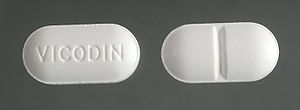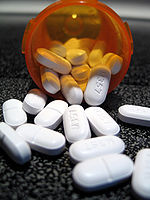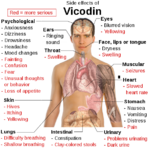Vicodin
| Vicodin | |
|---|---|

| |
| General | |
| Systematic name | 4,5a-Epoxy-3-methoxy- 17-methylmorphinan-6-one |
| Other names |
Vicodin ES |
| Molecular formula | C18H21NO3 x C8H9NO2 |
| Molar mass | Molar mass::299.368 g/mol |
| Appearance | White solid tablet. |
| CAS number | CAS number::330988-71-1 |
| Hazards | Prolonged use may lead to liver problems. |
| Except where noted otherwise, data are given for materials in their standard state (at 25 °C, 100 kPa) Disclaimer and references | |
Vicodin is an analgesic (pain reducing drug), which is a combination of hydrocodone and acetaminophen. It is a white solid tablet in appearance and is stable in various conditions. Although its prescribed use is fairly safe, it does have addictive side effects.
Properties
Vicodin is a combination of two pain reducing drugs. The two drugs, acetaminophen and hydrocodone, combined contribute both of their properties [1]. Hydrocodone is an opioid and has similarities with other pain-relieving properties. Opioids are often called narcotics and because of this, the names have become interchangeable. Opioids can also be used to relieve coughing and diarrhea. Hydrocodone produces a calming and euphoric nature in the person taking the drug [2]. Acetaminophen is a slightly less powerful pain reducer as hydrocodone, it also reduces fever. Tylenol is a common name for acetaminophen, which has a white, crystalline structure and is highly stable in temperature, light and moisture [3].
Manufacturing
Vicodin is made when the combination of hydrocodone and acetaminophen powers are mixed and are crystallized. The tablets contain more acetaminophen than hydrocodone. The drugs combine to alleviate pain while reducing the side effects of each individual drug. Vicodin is produced from Abbott Laboratories (makers of trademark Vicodin), Amerisource Health Services Corp, Cardinal Health, Drx Pharmaceutical Consultants Inc, Eckerd Corp, Hospira Inc, Mallinckrodt Pharm. Quality Care, Pdrx Pharmaceuticals Inc, Physicians Total Care Inc, Rx Papoo's Packaging Inc, and Watson Pharmaceuticals. [4]
Uses
Vicodin is used to treat moderate to severe pain. Acetaminophen is a light pain killer that evens out the pain relief powers of the narcotic hydrocodone [1]. Vicodin should be prescribed by a doctor; however, people have found that the drug numbs emotional and physical pain as well as causing a state of euphoria. In 2009, at least 10% of high school seniors admitted that they had taken Vicodin without a doctor’s prescription [5]. Though not prescribed by doctors as a cough suppressant, some people do use Vicodin to treat a cough Cite error: Invalid <ref> tag; invalid names, e.g. too many.
Vicodin Abuse
Vicodin abuse starts with pain. The people who have access to medical treatment are more likely to be addicted to Vicodin. These individuals are prescribed vicodin to relieve their pain from a surgery. They then begin to believe that the original dosage is no longer adequate nor strong enough to relieve the pain so they begin to take more and more until they can no longer live day to day without it.
The danger of becoming addicted to any drug is not really the addiction but rather the withdrawal. Signs of a vicodin addiction are dizziness, nausea, euphoria and vomiting[6].
House M.D.
Anyone who watches the TV show drama, House M.D., can see right away that the main character, Dr. Gregory House, is a Vicodin addict. Almost every time he is on screen, he can be seen popping a small handful of the drug. In the last episode of the 5th season, "Both Sides Now", House realizes that he is a drug addict and admits that he needs rehabilitation after having experienced some violent hallucinations. He agrees to go to a rehabilitation center. In the following episode, "Broken", the opening scenes show the doctor twisting and in agonizing pain on top of a rather flat bed in the hospital [7]
References
- ↑ 1.0 1.1 Vicodin 2000-2011 Drugs.com.
- ↑ Opioids 2002-2003 Drug Addiction
- ↑ Tylenol(Acetaminophen) 2011 by RxList Inc
- ↑ Hydrocodone/paracetamol 1 February 2011 Wikipedia.org.
- ↑ What is Vicodin used for? October 9, 2010 By Addiction Blog.
- ↑ Vicodin Addiction, Abuse and Treatment 02/05/2011 Addictionsearch.com
- ↑ The author is a fan of the show House MD and has watched it multiple times.
| ||||||||||||||


